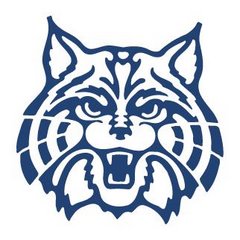The past few years, teams were turning to three-guard and four-guard
lineups in response to the dwindling number of dominating centers at
the college level. The small but quick ball-handlers and playmakers had
become the stars and the focus of the game, as the intimidating giants
in low post typically bypassed the college game and went directly to
the NBA.
But suddenly, the NBA's new minimum-age rule and a few coincidences
have altered the evolution of the game, and the big man is back.
Greg Oden, a 7-foot-1 dominator, would have been the No. 1
pick in the June NBA draft, but instead he's at Ohio State, and Arizona
coach Lute Olson says he's the best big man to come out of high school
in a long time.
"He has a chance to be a (Bill) Walton or a (Kareem) Abdul-Jabbar, someone of that caliber," Olson said.
In fact, the current crop of giants is reminiscent of the days
when Patrick Ewing, Ralph Sampson, Walton and Abdul-Jabbar (Lew
Alcindor, then) and Tim Duncan ruled the college landscape.
The 7-foot Lopez twins (Brook and Robin) at Stanford and 6-11
Spencer Hawes at Washington could have been lottery picks two years
ago, but they are college freshmen instead. Connecticut's 7-3 freshman
Hasheem Thabeet is swatting shots away at an alarming rate, and he
could challenge Oden as the best freshman big man this year, at least
until Oden returns from his wrist injury. Duke's 7-1 Brian Zoubek and
Kansas State's 7-2 Jason Bennett should make immediate impacts as
freshmen.
They join a strong group of returning big men. Florida's 6-11
Joakim Noah was expected to be the NBA's No. 1 overall pick last June,
but having a father (Yannick Noah) who was a champion tennis player
eliminated the financial necessity to turn pro, so he's back.
Aaron Gray, a 7-footer at Pittsburgh, came back, too as did
Kentucky's 7-foot center Randolph Morris and Georgetown's 7-3 Roy
Hibbert, who had improved by leaps and bounds and is ready to emerge as
a star.
Gonzaga's 6-11 Josh Heytvelt might replace Adam Morrison as
the Zags' main man, while Alabama's 6-10 Jermareo Davidson is a
challenge for Noah in the Southeastern Conference.
LSU's 6-9 Glen Davis, Duke's 6-10 Josh McRoberts, North
Carolina's 6-9 Tyler Hansbrough, and Nevada's 6-11 Nick Fazekas are not
really centers, but they play like big men, and they all could be in
the NBA right now. Instead they are stars on ranked teams, and most of
the preseason top 25 schools have a big man as their star.
Even the Pac-10, the cradle of point guards, will be heavy
with dominant big men. The conference's tradition of passing point
guards to the pros - Jason Kidd, Gary Payton, Jason Terry, Damon
Stoudamire, Mike Bibby, Luke Ridnour, Brevin Knight and Gilbert Arenas
are all NBA starters at the moment - could change, because this season
the Pac-10 is short on point guards and long on centers.
Cal 's top NBA prospect is 6-11 DeVon Hardin, a likely
first-round pick, and the best low-post player in the conference could
be Arizona State's 6-9 Jeff Pendergraph.
Predictions: North Carolina added three McDonald All-Americans
to aid Hansbrough; Kansas, led by Brandon Rush, is loaded with talent,
and Ohio State brought in several top freshmen besides Oden. The
pressure of repeating usually gets the better of teams, so preseason
No. 1 Florida might struggle.
We are picking North Carolina, which will be a lot better in
March than in November, to win the NCAA title, but keep an eye on
Alabama, which has the nation's best point guard (Ronald Steele), and
Georgetown, which might regain dominance under John Thompson III.
Unranked bliss: Two of the past four national champions -
Florida in 2006 and Syracuse in 2003 - were unranked in the preseason
poll. Maybe a team such as Louisville can pull off a similar surprise.
Return engagement: Florida is the first team since Arizona in
1998 to return all five starters from a national championship team. The
'98 Wildcats were clearly better than their 1997 version, finishing
first in the Pac-10 rather than fifth as the '97 Wildcats did, but the
'98 Arizona team lost in the round of 16 in the NCAA Tournament.
The 1995 Arkansas Razorbacks returned the top eight players
from their 1994 national championship squad. They struggled more than
expected in 1995 but got to the NCAA championship game before losing to
UCLA.
The 1968 UCLA squad appears to be the only team to win a
national championship after returning all five starters from the
previous season's national championship team. However, Kenny Heitz, a
starter in 1967, came off the bench in '68, when the Bruins started
Alcindor, Mike Lynn, Lucius Allen, Mike Warren and Lynn Shackelford.
Coaching changes: Sixty-one Division I teams have new head
coaches, with the most significant being Kelvin Sampson at Indiana,
Sidney Lowe at North Carolina State, Jeff Capel at Oklahoma, Sean
Sutton at Oklahoma State, Herb Sendek at Arizona State, Fran Dunphy at
Temple, Bobby Gonzalez at Seton Hall, Mike Anderson at Missouri and Bob
Huggins at Kansas State.
Huggins is already bringing in big-time talent to K-State.
Besides Bennett, he recently added Bill Walker, one of the nation's top
players, for this season, and signed Michael Beasley, rated as the
nation's No. 1 high school senior prospect by several recruiting
services, for next year.
The coach: Texas Tech's Bob Knight needs 10 wins to tie Dean Smith's record of 879 career coaching wins.
(Distributed by Scripps Howard News Service, www.shns.com.)
Copyright 2006, Knoxville News |

No comments:
Post a Comment